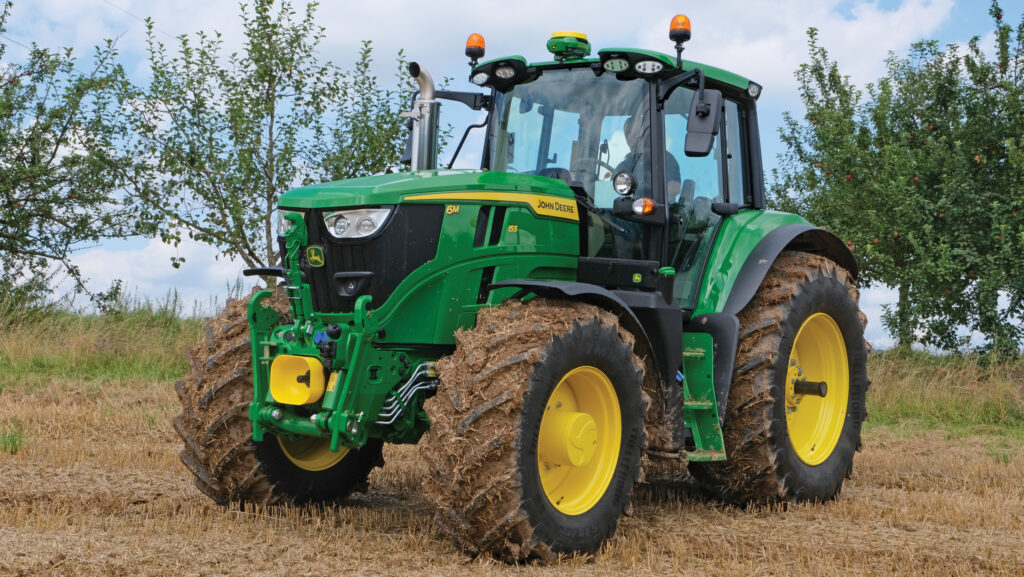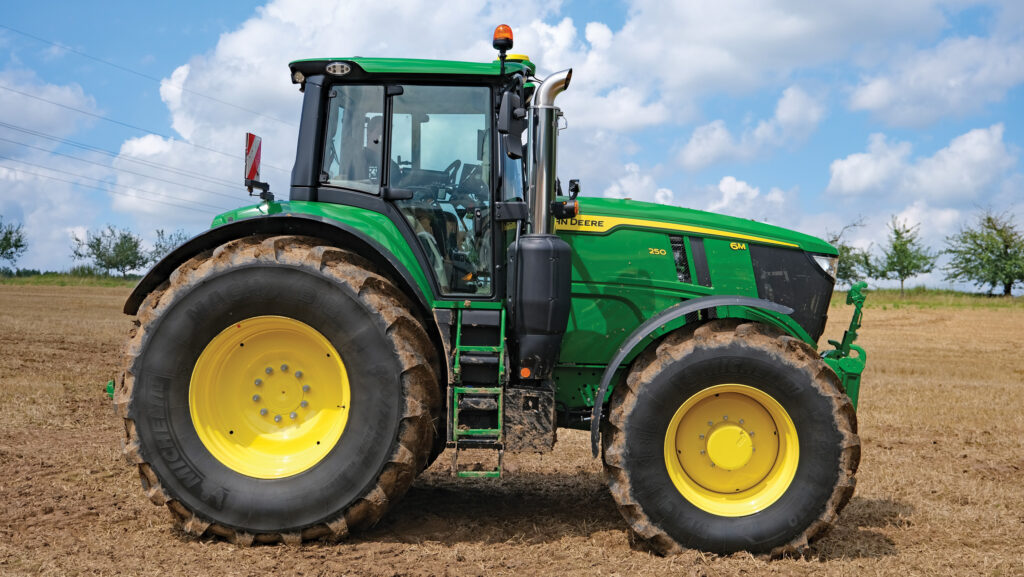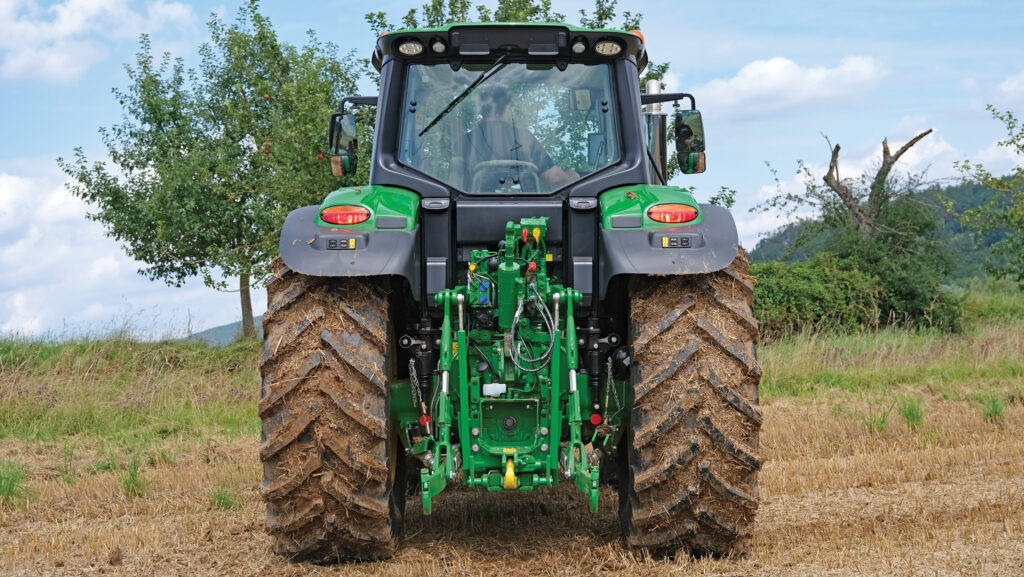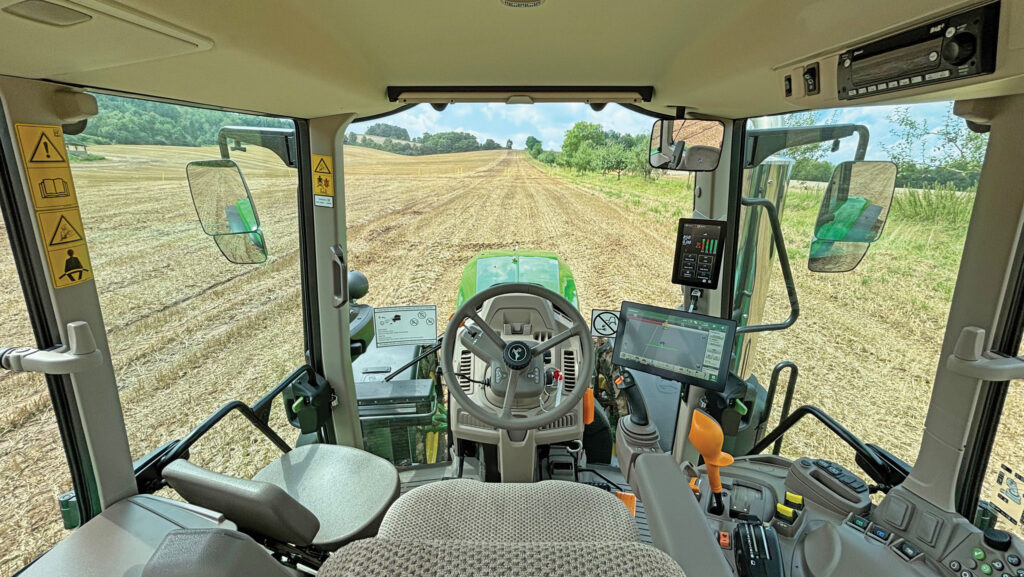First impressions: More power and speed for Deere 6M-series
 6M 155s have proved popular – just like the R-series equivalent © James Andrews
6M 155s have proved popular – just like the R-series equivalent © James Andrews They might be simpler and cheaper than their premium-spec cousins, but the lack of a 50kph transmission has long stymied sales of John Deere’s 6M tractors in the UK.
Keen to right this wrong, the firm has treated the range to a complete overhaul.
Top speed is now the same as the posher 6Rs, as is most of the running gear, and there are more models to choose from than there are colours on a paint chart.
Deere’s theory being that if it covers all the bases, its customers won’t be tempted to fraternise with its rivals.
See also: On test: John Deere’s 6R 185 tractor

The range-leading 6M 250 with its modestly-sized cockpit © James Andrews
A key example of this is the new entry-level, six-cylinder 6M 145 that matches up nicely to New Holland’s T6.180.
And with 17 variants across four chassis sizes, four transmissions, and max powers from 105hp to 275hp, there really is a model to suit most buyers.
For those unfamiliar with the 6M range, it’s effectively the “stockman” version of the 6R. This means less technology, reduced engine boost and – the big one – a lower-spec cab.
Essentially the same workspace introduced on the 6020 series in 2001, this is considerably smaller than the modern four-poster used on the Rs and has fewer creature comforts.
The only integrated screen is a modest corner post display and, although others can be brought in to run GPS, isobus and other high-tech features, these are very much bolt-on affairs.
That said, those who get carried away with the options list can bring a 6M within striking distance of a 6R, both in terms of spec and price.
As for the transmissions, three of them are based on the firm’s dependable semi-powershift box.
PowrQuad is the most basic and is rarely specced in the UK, overshadowed by the hugely popular AutoQuad with its speed matching and automatic shifting of powershift steps.
Then there’s CommandQuad – the most recent take on this cog arrangement – which ditches the manual gear lever in favour of robotised range changes, just like Massey Ferguson’s Dyna-4.
Finally, there’s the ZF-built AutoPowr CVT, which can now be fitted on all models.
Although 40kph is the still the standard top speed in these transmissions, 50kph is available as an option.
Finding a home
The question is, do all these updates make the 6M a more attractive prospect for UK farms?
In the smaller models, it’s easy to see that Deere is onto a good thing.
The “short frame”, chisel-nosed 6M 125 is already a popular loader tractor, so the faster top speed and other refinements will only add to its appeal.
But the biggest winner will likely be the “mid-frame” six-cylinder tractors, where the previous 40kph top speed will have been a deal breaker for many.
This four-model range starts with the 160hp max/171hp boosted 6M 145 and runs up to the 204hp max/213hp boosted 6M 185.
Ideal for haulage work and pulling balers, these tractors may well be fancied by buyers who need to travel long distances quickly and don’t want to waste money on features they rarely use.
They are also likely to be attractive for smaller farms that want a simple-yet-powerful all-rounder.
Sales are already strong for the 6M 145 and gutsier 6M 155, with the 6M 185 lagging slightly behind.
The main reason likely being that this model is only available with an AutoPowr CVT transmission.
Though this has become popular across all spec levels in a lot of countries, the UK is still wedded to simple and reliable semi-powershifts, particularly on small- to mid-sized tractors.
Stepless driving
However, with the updated M, Deere is hoping to gradually turn the tide.
To this end, it’s made AutoPowr available at every 6M spec level. This means it can be obtained on tractors with a basic right-hand console – no seat-mounted Command Arm required – and teamed with manual spool levers.
There’s plenty to like about this setup, particularly for tractors that are going to be used with a loader.
That said, while the AutoQuad semi-powershift has a reputation for bomb-proof reliability, some buyers will be conscious that the AutoPowr box can give trouble.
This is a far less common occurrence in current versions, however.

6M 155s have proved popular – just like the R-series equivalent © James Andrews
Higher horsepower options
Previously, the 6M series topped out with the “large frame” 6195M, but now it runs all the way up to the “extra-large frame” 6M 250.
With a max power of 275hp, boosting to 281hp for transport and pto work, it offers roughly the same output as the 6R 250.
The only difference in the premium-spec model is an extra 20hp of boost, which is also available for hydraulic functions.
Though there’s got to be some demand for these extra-large models in M guise, it’s hard to see many buyers being tempted away from an R, unless there are some stonking deals flying around.
And while the smaller cab looks perfectly acceptable on shorter-framed tractors, these big ’uns look a bit like an elephant wearing a top hat.

Slightly more tech, but the cab frames are essentially the same as those on 6930s and 7530s © James Andrews
Tech if you want it
Simple as they are in entry-level form, the Ms have plenty of technology on offer should customers want to add it.
Autosteer is available throughout the range and the simple corner post display can be accompanied by a 10.1in G5 or 12.8in G5 Plus screen for running GPS and isobus implements.
These are attached rather crudely via a bracket on the A-pillar. But Deere has gone to the trouble of fitting internal wiring so that cables don’t have to be draped around the cabin.
This setup also makes the tractors compatible with JD Link, so dashboard and job information can be beamed over the airwaves to the firm’s Operations Center app.
Fancy R-spec loaders can be fitted too, which are controlled via an electronic joystick – the only caveat being that drivers can’t unlock the full range of features, such as weighing and return-to-dig.
On the controls front, all models with a manual gear lever have a fixed bank of switchgear on the right, but CommandQuad or AutoPowr versions can be fitted with a compact armrest-mounted console.
As for retail prices, the popular four-cylinder 6M 125 with a 50kph AutoQuad transmission starts at £106,932, with a similarly specced six-pot 6M 155 available from £132,336.
The AutoPowr-only 6M 185 is £159,918, which represents a £37,000 saving over a similar spec 6R 185. Although, this margin would be a narrower if we were talking on-farm prices.
Verdict
Upgrading the Ms to a 50kph transmission and beefing up the running gear means there’s now very little separating it and the R series, other than the cab.
So, for those content with a smaller workspace and nonplussed for the latest technology, there are some welcome savings to be had.
For smaller models, it seems a particularly easy decision to opt for the M spec.
And, judging by the continuing popularity of the 6930 and 7530 (which essentially have the same cab), it’s a solid bet for those wanting a simple 200hp tractor.
But for anyone getting carried away with the options list, it probably makes sense to stick to an R and enjoy some extra space for your flask and lunch box.
Likes and gripes
Likes
- 50kph transmission option
- Simple to drive
- Loads of spec options
Gripes
- Cab too small for larger models
- Bolt on G5 screen is a little crude
- Not that much cheaper than a 6R
6M model line-up |
|||
|
|
Wheelbase (frame size) |
Engine |
Max/boosted horsepower |
|
6M 250 |
2.9m (extra-large frame) |
6.8-litre six-cylinder |
275/281 |
|
6M 230 |
253/260 |
||
|
6M 240 |
2.8m (large frame) |
264/270 |
|
|
6M 220 |
242/249 |
||
|
6M 200 |
220/229 |
||
|
6M 180 |
198/208 |
||
|
6M 185 |
2.77m (mid-frame) |
204/213 |
|
|
6M 165 |
182/192 |
||
|
6M 155 |
171/182 |
||
|
6M 145 |
160/171 |
||
|
6M 150 |
2.58m (small frame) |
4.5-litre four-cylinder |
165/177 |
|
6M 140 |
154/166 |
||
|
6M 130 |
143/156 |
||
|
6M 125 |
2.4m (short frame) |
138/150 |
|
|
6M 115 |
126/140 |
||
|
6M 105 |
116/130 |
||
|
6M 95 |
105/120 |
||

